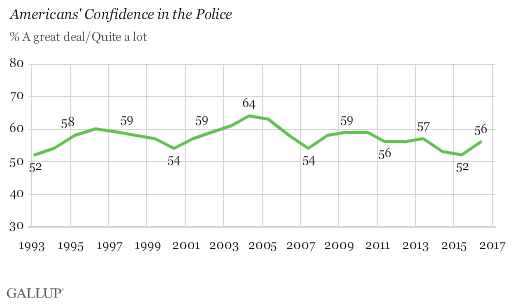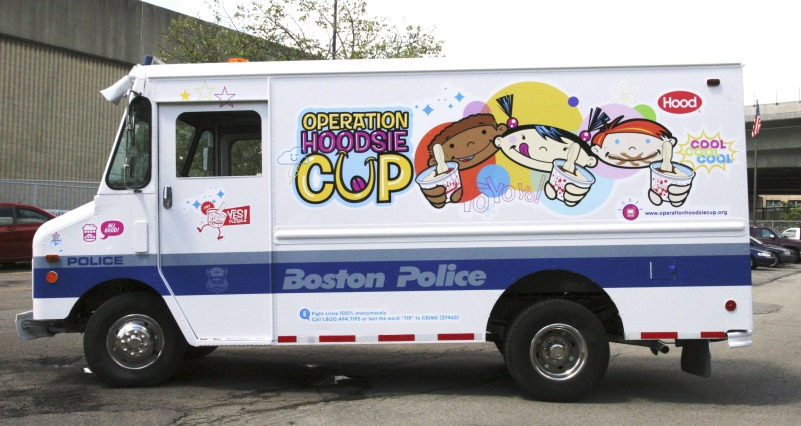The National and Local Police Trust Gap
By Kyle Harvey
December 13, 2016
The United States has reached a critical juncture in community relations with police. After two horrific videos surfaced within the same week of July showing police shooting unarmed black men—Philando Castile and Alton Sterling—the influential Black Lives Matter movement continued to fervently protest the racial bias inherent in American law enforcement. Following the misguided retaliation and murder of three Dallas cops, President Obama encouraged a restoration of trust and mutual understanding between local police forces and their respective communities. Much of the trust deficit in community-police relations can be attributed to statistical differences in how police treat different races, making community outreach vital in healing those injustices. As far as data is concerned, Boston has built some of the strongest trust in the nation between citizens and police.
Nationally, American confidence in police reached a historic low in 2015. Only 52 percent of Americans had “a great deal” or “quite a lot” of confidence in police according to a Gallup’s 2015 polling of Americans confidence in institutions. Since then, confidence in police has rebounded slightly, reaching 56 percent in Gallup’s 2016 polling. During the 22 year tracking period, confidence in police has remained within the narrow interval between 52 percent and 64 percent, implying growing wariness of law enforcement in recent years. The last time only 52 percent of Americans had a high level of confidence in their police was in 1993, when four LA police officers were acquitted in their trial for the beating of Rodney King. Despite a relative low, the police force remains one of the highest ranking institutions in terms of American trust; it trails only small business and the military.
For good reason, trust in police varies by demographics. In 2015, only 30 percent of the Black population and 42 percent of the Hispanic population had a high level of trust in police compared to 57 percent of whites. Although the publicized police shootings of unarmed black men contribute to distrust of police, 2015 does not represent an outlier year. In fact, as far back as the data goes, minorities report more distrust in police than whites do. For this reason, Blacks confidence in police has not declined disproportionately compared to whites in these turbulent years; they already had low confidence in law enforcement.
The African American population is justified in their greater distrust of police due to empirical evidence that police treat blacks differently than they do whites. A Special Report by the U.S. Department of Justice on police behavior during street stops found that relatively more black drivers (13 percent) than white drivers (10 percent) were pulled over by police officers. Furthermore, of those involved in street stops, a smaller percentage of blacks than whites believed the officers behaved properly during the stop. The National Bureau of Economic Research published an analysis on racial difference in police use of force that corroborates perceptions of unfair treatment. The study tracked various indicators that revealed law enforcement were more likely to use force and resort to weapons, specifically with regards to black citizens in New York City.
In terms of improving community policing methods, Boston has made numerous strides reflected in the city’s levels of trust. According to a July poll by MassINC commissioned by the Boston Foundation following the Castile and Sterling incidents, 73 percent of residents view Boston police favorably. Interestingly, this is much higher than the national figures. To be fair, there is still a divide in trust levels between races in Boston; 83 percent of whites view Boston police favorably compared to 65 percent of black residents. In light of increased tension between minorities and police, Boston Police Commissioner William B. Evans views these results as encouraging, although he still wants to close the gap.
Boston police have prioritized building relationships between officers and residents as a prerequisite for effective community policing. For example, Boston hosted National Night Out, an
event designed to highlight the partnership between communities and officers. During the event, Mayor Walsh and Commissioner Evans met with residents at stops in Brighton Commons, Lacono Field in Hyde Park, and Adams Park in Roslindale to listen to music, eat cotton candy, and celebrate mutual respect. In a similar lighthearted effort, Boston Police initiated Operation Hoodsie Cup; a perilous mission to hand out free ice cream to kids that required adding an ice cream truck to the patrol fleet. Boston police devote resources to strengthening their bond with the community, especially as it pertains to generating goodwill between youth and officers.
This doesn’t mean Boston has turned a blind eye to implicit bias in the police institution. On July 14, WCVB-TV hosted a town hall forum in partnership with the Boston Foundation, that explored issues of fairness in the city against the backdrop of a national conversation about race and law enforcement. A panel of local Black and Latino leaders explored issues of racial profiling, police brutality, and social and economic inequities with a diverse audience. The Boston Police Department have also taken actionable steps introducing a body camera pilot program where officers will record footage while on duty. Perhaps most encouraging of all, Commissioner Evans and Boston City Councilors promise routine public forums on the body camera program, hoping to make law enforcement procedures more transparent.


